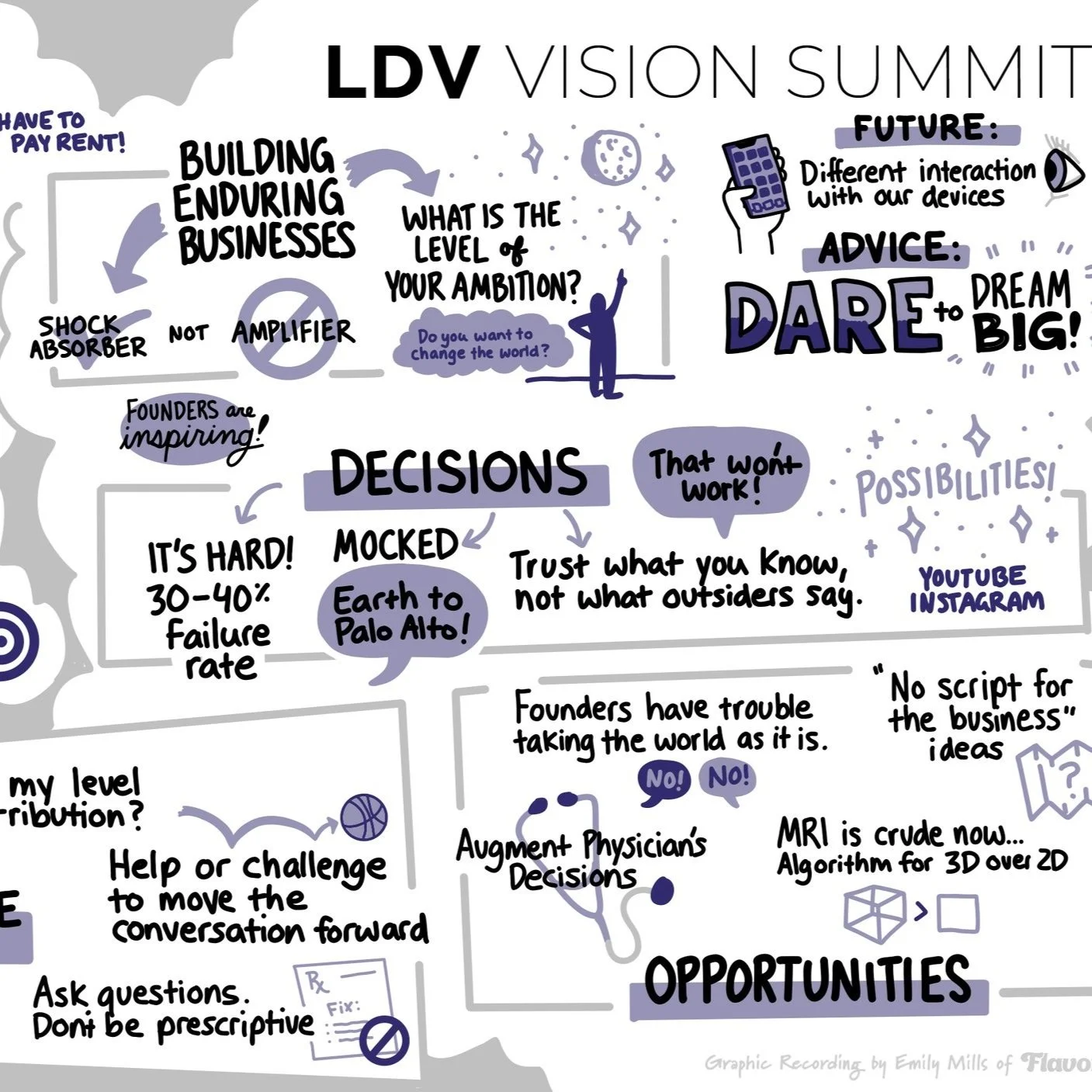Living Longer & Healthier: How Visual Tech will Advance Accelerations in Life Sciences & Biotech
/The global bioeconomy, defined as all activity enabled by innovation and research in biotechnology, accounted for about $5 trillion, or nearly 6% of global GDP in 2019. By 2030, the world bioeconomy is expected to exceed $20 trillion in GDP. As the biotech industry relies heavily on data filtering, analysis and sharing, visual technologies will become critical for the detection and imaging of biological systems, paving the way for the future of life sciences tools enabling next-generation therapeutics, biomanufacturing & longevity.
Since 2012, we at LDV Capital have been the only venture fund with the thesis of investing in people building businesses powered by visual technology and artificial intelligence (AI). We define visual technology as any technology that captures, analyzes, filters, displays, or distributes visual data across the light and electromagnetic spectrums.
We expanded our team's expertise in life sciences & biotech with the addition of brilliant domain experts, Laura Smoliar & David Rabuka. Laura Smoliar earned her Ph.D. in Chemistry from UC Berkeley. In 2005, Laura founded Mobius Photonics, which developed high-power fiber-based UV and green lasers and was acquired by IPG Photonics. In 2016, Smoliar co-founded the Berkeley Catalyst Fund, where she made a number of early-stage biotech investments. Earlier this year, she became the Executive Director of the Taiwan Science & Technology Hub at Stanford University. Join our 10th Annual LDV Vision Summit – a free virtual event on March 21, 2024 – to e-meet Laura and learn more about the latest developments in biotech & life sciences.
David Rabuka’s expertise is concentrated on translating new technologies into clinical therapies. He is the co-founder, CEO and President at Acrigen Biosciences, an early-stage life science gene editing company based in Berkeley. The company is building a pipeline of therapies to treat genetic disorders using its cutting-edge proprietary precision gene editing technology. David previously co-founded Redwood Biosciences with Nobel Prize winner Carolyn Bertozzi, which was acquired by Catalent Pharma Solutions in 2014.
Next-Gen Therapeutics
Next-generation life sciences tools incorporating machine learning (ML) and artificial intelligence (AI) are enabling researchers to visualize the design of new molecules by analyzing large-scale datasets in order to predict the potential efficacy of drug candidates. Machine learning and more accessible & advanced computing have resulted in the processing of more dense data sets, such as high-resolution images, elucidating new targets that can be designed using AI to access previously "undruggable targets," including low-hit-rate proteins and challenging-to-treat diseases.
“As supercomputing hardware becomes more powerful and more accessible to academic researchers and startups, the pace of development at the intersection of AI and drug discovery will accelerate and create many new investment opportunities at the early stage. I’m excited to see how NVIDIA’s Cambridge -1 and Tokyo -1 supercomputers open up the playing field.” - Laura Smoliar
A type of screening within drug design & discovery is phenotype screening, for the identification of smaller molecules or peptides that alter the phenotype of a cell or organism in a certain way. ML-based genetic profiling platforms can create a map of the entire genome, scanning for hotspots and potential targets. Generative algorithms are also able to design custom molecules from scratch, based on algorithms that generate predictive experiments of how molecules will interact. Current modeling suggests that AI for drug discovery can improve time and cost savings by at least 25-50%, fundamentally changing the economics of how many drug targets can be tested and how many can succeed. Oxford-based clinical-stage biotech Exscientia focuses on drug discovery of small molecules for various therapeutic indications using its patient-first AI-driven platform CentaurAI. Founded in 2012, the company IPO'd in 2021 and is one of a growing list of publicly traded AI-driven drug discovery platforms.
The cell therapy market is expected to reach $20 billion by 2026. The efficacy of cell therapy techniques has greatly improved since 2017, when the first chimeric antigen receptor (CAR) T cell therapy was approved. Nevertheless, new approaches across cell therapy platforms are leveraging visual technology to optimize the scaling of manufacturing, a key bottleneck. Synthetic gene circuits, created by engineering networks of genes, are attempting to improve safety outcomes, one of the hardest factors to predict. The growth of synthetic biology will be a key trend across the next decade of new platforms for both cell therapy and gene editing.
Computational protein design is another revolutionary technology for chemical biotechnology. In July 2021, an AI system by DeepMind called AlphaFold predicted the protein structures for 330,000 proteins, including all 20,000 proteins in the human genome. The AlphaFold Protein Structure Database has since expanded to include over 200 million proteins, covering nearly all cataloged proteins known to science. Over the next decade, the global protein engineering market is forecasted to grow at a compounded annual growth rate (CAGR) of over 13%, as precise modifications in protein sequences continue to be enabled.
We look forward to celebrating our 10th LDV Vision Summit Anniversary virtually with you on March 21, 2024! Over 20 fantastic speakers ranging from tech giants to under-the-radar startups, esteemed research labs and leading venture capital firms will be sharing their insights on state-of-the-art computer vision, machine learning, and AI solutions aimed at improving the world we live in. Meet the first two: Roelof Botha of Sequoia Capital and Esther Dyson of Wellville.
Biomanufacturing
Digital technologies are rapidly expanding the development of biomanufacturing applications, such as 3D bioprinting and nanofabrication. Bioprinting is an additive manufacturing process where the printing of cells and biomaterials creates organ-like structures. 3D bioprinting is a further example of how visual technology is playing an instrumental role in the future growth of biotech applications.
The creation of living tissues such as blood vessels, bones, heart, or skin, holds the promise to address challenges with the current use of animal testing for chemical and pharmaceutical products as well as a worldwide organ shortage. Estimates believe that there will be fully functioning organs bioprinted within the next decade. Researchers at the University of Illinois Chicago have developed a method to create 3D-printed cell-loaded bioink constructs that can change shape over time, just like tissues in the body do. We can eventually not only model the development of human tissue but also model the development of human tissue as it changes according to the effects of external stimuli.
The purpose of nanofabrication is to produce nanoscale structures to form a device in larger quantities and at a lower cost. Combining nanotechnologies with biotech has given way to bio-nanofabrication, where the manipulation of matter molecule-by-molecule results in building complex bio-nanostructures on surfaces with nanometer precision. Currently, studies have shown that soft lithography can be used to fabricate DNA arrays. The future of nanolithography techniques will incorporate multi-step processing, as well as improving feature resolution in order for the patterning of biomolecules to be maximized in terms of resolution, fidelity and process reliability. Augmenting the efficiency of biomolecules going forward will play a significant role in how pharmaceutical development and food production occurs.
Longevity Tech
Visual technologies are identifying biomarkers for longevity to bridge the gap between personalized preventative longevity medicine and healthier living, improving both life span and health span. Across the past decade, new developments to measure biological age have come to the fore for humanity to better understand the rate of aging and indicators of overall health. Wearables capture biomarker data such as heart rate variability to track the body’s resilience and ability to manage stress. Newer developments include epigenetic clocks, a way to measure DNA methylation. Blood biomarker analysis combines data from blood samples with ML to calculate how lifestyle choices and behaviors affect the aging process.
By 2034, the US Census Bureau predicts that the number of people over the age of 65 will outnumber those under the age of 18 for the first time in American history. There is an urgent need for regenerative medicine innovations, and stem cell-based therapy has recently emerged as a key player in the space. Stem cell therapy is a novel therapeutic approach that utilizes the unique properties of stem cells, including self-renewal and differentiation, to regenerate damaged cells and tissues in the human body or replace these cells with new, healthy and fully functional cells by delivering exogenous cells into a patient. Key areas where stem cell therapy will be most valuable are digestive system diseases and cardiovascular diseases. Going forward, the capturing, visualization & analysis of genetic data will underline how we better re-engineer the human body to restore sustainable function.
“The future of life sciences & biotech married with visualization technologies holds the promise of unlocking promising therapies and medical advancements at a scale and with a depth never before imagined, illuminating the path to breakthroughs that will revolutionize medicine and our understanding of human biology.” - David Rabuka
At LDV Capital, we believe there will be significant value for businesses and society by leveraging visual technologies to help us live longer and healthier. Let us know if you are either thinking of building or have already started building a startup leveraging visual technologies and AI in the life sciences & biotech space.
This article was written in collaboration with Ash Cleary, Analyst at LDV Capital.











